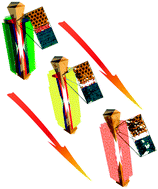Imaging the effect of a hydrothermal treatment on the pore accessibility and acidity of large ZSM-5 zeolite crystals by selective staining
Abstract
Confocal fluorescence microscopy has been used in combination with bulky non-reactive dyes (i.e. proflavine, stilbene and nile blue A) and two staining reactions (i.e. fluorescein synthesis and 4-fluorostyrene oligomerisation) to study the effect of steaming on pore accessibility and acidity of large ZSM-5 zeolite crystals. This approach enabled the 3-D visualization of cracks and mesopores connected to the outer zeolite surface as well as mesoporous “cavities” within steamed ZSM-5 zeolite crystals. It has been found that besides the generation of mesoporosity steaming makes the boundaries between the different crystal sub-units accessible for bulky molecules. Additionally, the fluorescein staining reaction reveals prominent formation of structural defects that are connected to the surface of the crystal via the microporous ZSM-5 system and which contain either Brønsted or Lewis acid sites. On the other hand, the 4-fluorostyrene staining reaction shows how mild steaming conditions increase the accessibility towards the Brønsted acid sites, while under severe steaming conditions the Brønsted acidity contained in the internal crystal sub-units is more accessible, although it is preferentially removed close to the surface of the lateral sub-units of ZSM-5 zeolite crystals.


 Please wait while we load your content...
Please wait while we load your content...